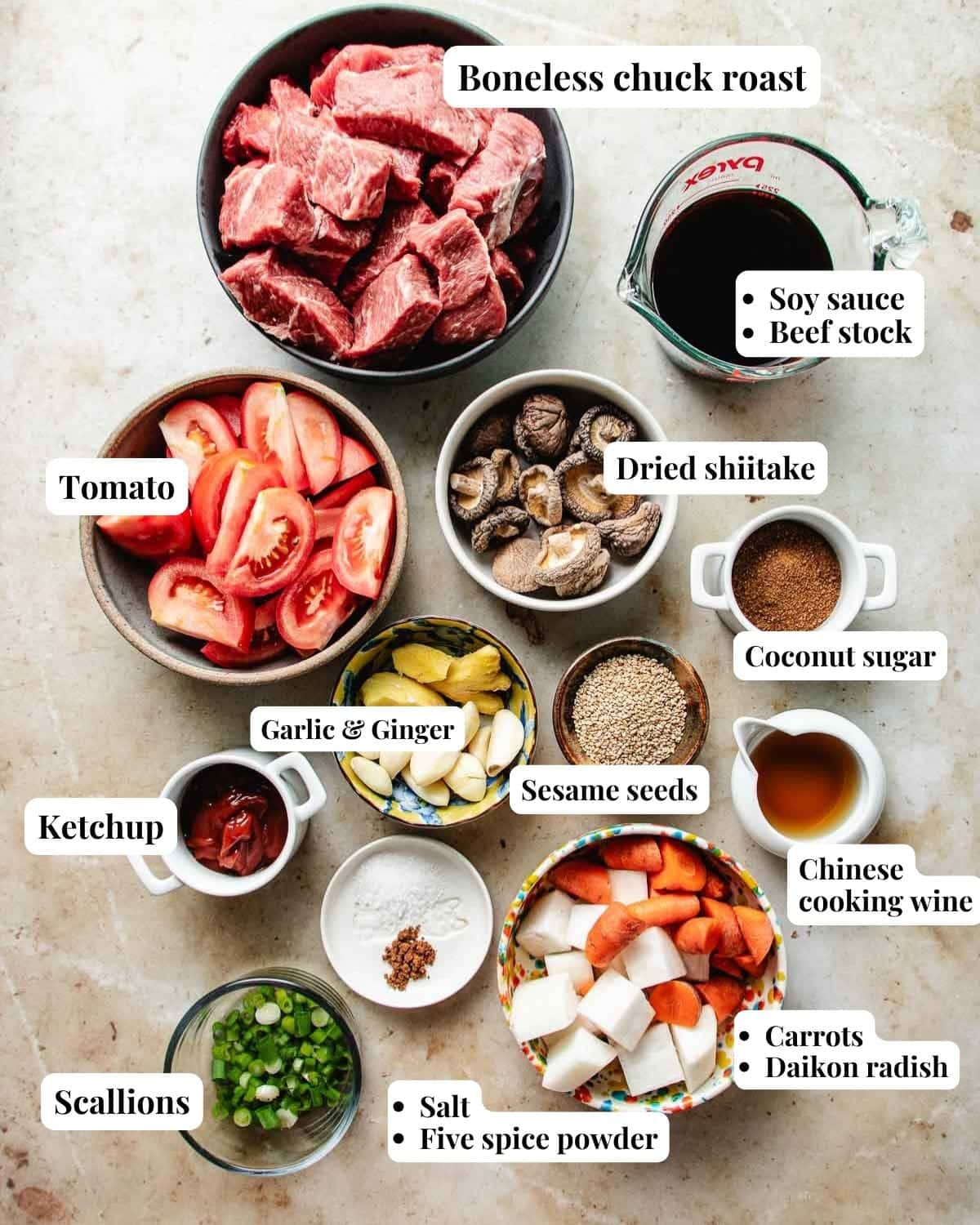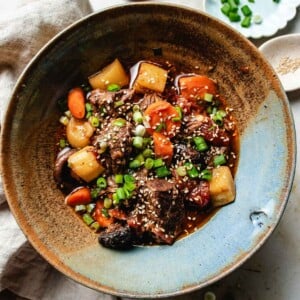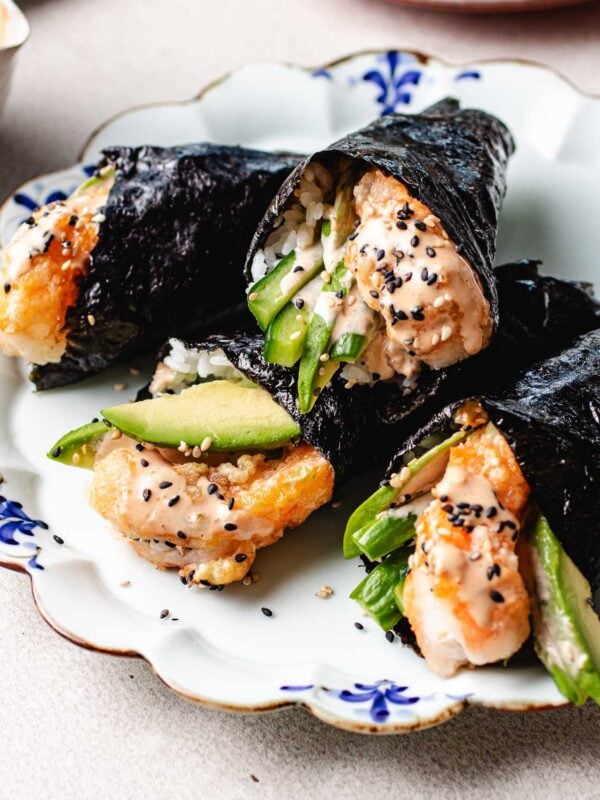This post may contain affiliate links. Please read our disclosure policy.
This Chinese beef stew with daikon is hearty, rich, and perfect for winter nights. The other day, I was at the grocery store, and I noticed a bunch of people buying chuck roast. It caught my attention because I was about to do the same!
I love using chuck roast because it’s an affordable cut with a deep, beefy flavor, and it turns melt-in-your-mouth tender. This recipe comes with both pressure cooker and slow cooker instructions, so you can enjoy tender beef no matter how much time you have.

Table of Contents
ChihYu’s tips
- Choose the right cut: Use a well-marbled cut with a good fat-to-lean ratio, like chuck roast or boneless beef shank, to keep the beef tender and moist during cooking. Collagen from the meat breaks down to give you that melt-in-your-mouth texture.
- Beef stew selection: Chuck roast and boneless beef shank are the top choices. If using beef brisket or stew meat, keep in mind that brisket may be slightly drier.
- Soak the beef: Soaking the beef in water before cooking helps remove impurities and creates a glossy, flavorful broth.
- Add daikon and carrots later: Add the turnip and carrots after the beef is tender to keep them from turning mushy. Dice them into smaller pieces so they cook faster.
- Pressure cook or slow simmer: This recipe provides both methods, but if you’re short on time, pressure cooking delivers tender beef in under an hour.
Ingredients
This Chinese braised beef stew uses ingredients you can easily find at your local grocery store. I’m particularly fond of using chuck roast for braising and stewing because it’s an affordable cut with a rich, beefy flavor—perfect for this stew!

Save This Recipe
- Boneless chuck roast: A well-marbled cut that turns tender and flavorful after slow cooking.
- Substitute: Boneless beef shank or well-marbled brisket also work great.
- Light soy sauce: Adds a deep, savory umami flavor to the stew.
- Substitute: Coconut aminos can be used for a soy-free option.
- Beef or chicken stock: Forms the flavorful liquid base for the stew.
- Garlic cloves: Infuses the stew with a rich, aromatic flavor.
- Fresh ginger: Adds warmth and a touch of spice to balance the richness of the beef.
- Ketchup: Contributes a bit of tang and natural sweetness to enhance the sauce.
- Coconut sugar: Adds a subtle sweetness to balance the savory flavors.
- Substitute: Brown sugar works just as well.
- Toasted white sesame seeds: Adds a nutty flavor and a slight crunch.
- Vine tomatoes: Contribute natural sweetness and acidity to balance the richness of the beef.
- (Small) dried shiitake mushrooms: Adds a deep, earthy umami flavor to the stew.
- Substitute: If using fresh shiitake, increase the amount and slice the caps before adding.
- Carrots: Add natural sweetness and color to the stew.
- Daikon radish: Lightens the stew by balancing the richness of the beef with its mild, slightly sweet flavor.
- Coarse sea salt
- Five spice powder: Adds a warm, aromatic flavor with hints of anise and cinnamon.
- Chinese shaoxing wine (optional): Adds depth and a slightly sweet undertone to the stew.
- Starch (optional): Thickens the stew for a heartier texture.
- Scallions: Adds a fresh, mild onion flavor as a garnish.
- Substitute: Cilantro or parsley can also be used for garnish.
How to make Chinese braised beef with daikon
This Chinese braised beef stew is simple and straightforward. I’ve simplified the traditional method, and you’ll find both Instant Pot and slow cooker instructions. Below is a quick overview with step-by-step photos, and for the full recipe, check out the recipe card at the bottom.
Prepare the Beef:

- Trim and soak the beef: Trim excess fat and dice the beef into 2.5 to 3-inch chunks. Soak in room temperature water for 10 minutes to 1 hour to remove impurities.
- Blend the sauce: Blend the soy sauce, stock, garlic, ginger, ketchup, sugar, and sesame seeds until smooth.
- Add to the pot: Drain and rinse the beef, then add it to the Instant Pot along with tomatoes and mushrooms.
Instant Pot Method:

- Cook: Set the Instant Pot to Pressure Cook on High for 40 minutes. Let the pressure release naturally for 15 minutes, then vent the remaining steam.
Slow Cooker Method:
- Cook: Select More/High Sauté to bring the mixture to a boil. Lock the lid and slow cook on High for 7-8 hours, until the beef is tender.
Season and Finish:
- Add vegetables: Skim off any fat, then add the carrots and turnip radish. Cook on Sauté for 15 minutes until tender.
- Optional wine: Add a splash of Chinese cooking wine, cooking for 30 seconds to evaporate the alcohol.
- Optional thickening: Stir in the starch slurry to thicken the broth if desired.
Serve:
- Garnish and enjoy: Transfer the stew to a serving bowl, and garnish with scallions and extra sesame seeds.
Why is Asian beef stew so tender?
The secret to making Asian beef stew so tender is choosing the right cut of beef and cooking it the right way. A well-marbled cut like chuck roast has plenty of collagen, which breaks down as it cooks, giving the beef that melt-in-your-mouth texture. To keep it simple, I recommend using a pressure cooker or slow cooker to make the stew.
What to serve it with
In my household, we like to pair this hearty beef stew with a light and refreshing side to keep the meal balanced. My mom also loves serving it with rice or noodles, so here are some popular go-to dishes that we enjoy as a family:
- Rice/Noodles: Steamed white rice, Din Tai Fung fried rice, or any boiled Asian noodles are perfect for soaking up the rich stew broth. For a low-carb option, shirataki fried rice works beautifully.
- Stir-Fried Greens: Yu choy with garlic sauce, Chinese broccoli stir fry, and Snow pea leaves stir fry all add a fresh, savory balance to the richness of the beef stew.
- Refreshing Sides: Bok choy salad, Chinese smashed cucumber salad, or Asian pickled cucumbers bring a refreshing crunch that complements the deep flavors of the stew.
More Chinese stew recipes you might like
If you loved this Chinese beef stew, you’ll want to try these other delicious recipes!
- Instant Pot Taiwanese Beef Stew: Made with bone-in beef shank, this stew is rich and full of flavor, perfect for a cozy dinner.
- Vietnamese Beef Stew (Bo Kho): Packed with aromatic spices and tender beef, this Vietnamese classic is a must-try.
- Taiwanese Braised Beef Noodle Soup: Using boneless beef shank, this comforting noodle soup is hearty and satisfying.

Chinese beef stew recipe

Video
Ingredients
- 2.5 lbs boneless chuck roast or boneless beef shank
- 0.5 cup soy sauce or coconut aminos
- 0.5 cup beef or chicken stock
- 8 medium garlic cloves peeled
- 1.5 oz fresh ginger peeled and roughly chopped (about 4 -inch piece)
- 3 tbsp ketchup
- 3 tbsp coconut sugar or brown sugar
- 2 tbsp toasted white sesame seeds plus more to serve
- 3 whole vine tomatoes sliced
- 10 small dried shiitake mushrooms about 1 oz.
- 2 medium carrot cut into 1-inch cubes, about 8 oz
- 2 medium daikon radish peeled and cut into 1-inch bites, about 15 oz.
- ½ tsp coarse sea salt or more to taste
- ¼ tsp five spice powder
- Splash Chinese cooking wine optional
- 2 tsp starch to thicken, optional
- 4 bulb scallions thinly sliced on the diagonal, or cilantro/parsley
Instructions
Prepare the beef:
- Trim away excess fats and dice into roughly 2.5 to 3 inch chunks.
- In a large bowl, cover the beef with room temperature water. Set aside for at least 10 minutes or up to 1 hour. This helps remove impurities so the braising liquid becomes shiny and glossy.
- In a blender, combine the soy sauce, stock, garlic, ginger, ketchup, sugar, and sesame seeds. Puree them until smooth, about 1 minute.
- Pour the mixture into a 6-quart Instant Pot. Drain the beef and briefly rinse under running water, then arrange them in an even layer in the pot and add the tomatoes and mushrooms.
Instant Pot:
- Lock the lid and move the valve to Sealing. Select Pressure Cook or Manual on High for 40 minutes.
- When the cooking is complete, let the pressure reduce naturally for 15 minutes, then release the remaining steam by switching the valve to Venting. Press Cancel, then carefully open the pot.
Slow Cooker:
- Select More/High Saute and bring the mixture to a boil. Press Cancel. Lock the lid and switch the valve to Venting. Select Slow Cook and set the temperature to More/High. Set the cook time for 7 to 8 hours; the beef is done when a skewer inserted into the meat meets no resistance.
Season and Finish:
- Using a large spoon, skim off and discard the fat from the surface of the cooking liquid. Select Normal/Medium Saute, then add the carrots and daikon. Cook and stir occasionally until the vegetables are tender, about 15 minutes. Stir in the salt and five spice powder.
Optional wine:
- Add a splash of Chinese cooking wine and cook for 30 seconds to allow the alcohol to evaporate.
Optional thickening:
- To thicken the broth, pour in the slurry – starch mixed with 2 tbsp water – and stir the pot for 30 seconds to thicken.
Serve:
- Press Cancel. Transfer the beef to a large serving bowl. Sprinkle with scallions and extra sesame seeds to garnish.
Notes
- Chuck Roast Alternative: You can use boneless beef shank or a well-marbled brisket instead of chuck roast. In the U.S., stew meat is often the same as sliced chuck roast. Confirm with your butcher before buying.
- Shiitake Mushrooms: I use small dried shiitake mushrooms in this recipe, which don’t need to be rehydrated. If using larger dried shiitake, rehydrate them first. You can also use fresh shiitake—just increase the amount and slice the caps before adding to the pot.
- How to Tell When Daikon Is Cooked: Daikon is done when you can easily pierce it with little resistance, and it turns from pale white to slightly translucent.
- Balancing the Stew: Daikon helps cleanse and balance the richness of the beef, preventing the stew from becoming too heavy or greasy.
- Cutting Vegetables: Dice the daikon and carrots into smaller, evenly sized chunks to ensure they cook quickly and evenly.
- Store and Reheat: Let the stew cool to room temperature before storing it in an airtight container in the fridge for 3–4 days. When reheating, take out the portion you need. The stew will gelatinize, so thin it with a little water and reheat on the stovetop until warmed through.
- Freeze: Store in a freezer-friendly container or bag for up to 3 months.
- Leftover Stew Liquid: The leftover liquid is packed with flavor. Thin it out and turn it into a noodle soup!
Nutrition
Nutrition information is automatically calculated, so should only be used as an approximation.
Made a dish and loved it? Please rate the recipe and leave a comment in the section below! It helps my blog grow organically, allowing me to continue sharing free and awesome content with you. Thank you!













Massive Hit. The broth is intensely flavorful which is a nice bump for usually limpy stews. Note that I would not say the serving size is 6 but 4 We had a couple of men that didn’t feel like they received enough. Nonetheless, this stew is delightful. PS I didn’t have access to daikon so I subbed red radish and it was a nice way to lower the carb content. No one noticed.
Thank you for sharing, Janet! Love to hear that red radish worked well. To feed hungry boys :). you can increase the recipe quantity adjustments (inside of the recipe card) or add another half to 1 pound of beef! My husband loves this dish very much, too. He said it reminded him of Taiwan! :))